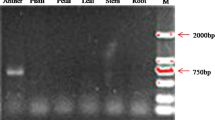Abstract
The effects on anther development of a fusion of the Arabidopsis anther-specific apg gene promoter to a ribonuclease (barnase) in transgenic tobacco plants were examined. Contrary to expectations, viable pollen grains were produced by these plants despite the demonstration that ribonuclease expression in the microspores and tapetum caused targeted cell ablation. Transformed plants were reduced in male fertility due to ablation of a proportion of pollen dependent on apg-barnase locus number. Plants were otherwise phenotypically normal and fully female fertile, confirming the anther-specific nature of the apg promoter. In microspores inheriting an apg-barnase locus following meiosis, loss of cell viability, as judged by fluorescein diacetate staining, occurred during mid to late microspore development. Microspores not inheriting a transgene went on to mature into viable pollen grains. Premature degeneration of the tapetum was also observed as a result of apg-barnase expression, but this did not appear to disrupt the subsequent microspore and pollen developmental programmes. This was substantiated by observations of microspore development in plants in which the tapetum was rescued from ablation by crossing in a second transgene encoding a tapetum-specific inhibitor of the ribonuclease. It was determined that tapetum cell disruption occurs at the early to mid uninucleate microspore stage in apg-barnase transformants. The data presented show that after this point in microspore development the tapetum is no longer essential for the production of viable pollen in tobacco.
Similar content being viewed by others
References
Aarts MGM, Dirkse WG, Stiekema WJ, Pereira A (1993) Transposon tagging of a male sterility gene in Arabidopsis. Nature 363:715–717
Blackmore S, Knox RB (eds) (1990) Microspores, evolution and ontogeny. Academic Press, London.
Chaudhury AM (1993) Nuclear genes controlling male fertility. Plant Cell 5:1277–1283
Chen R, Smith AG (1993) Nucleotide sequence of a stamen- and tapetum-specific gene from Lycopersicon esculentum. Plant Physiol 101:1413
Crossley SJ (1993) The characterisation of tapetum-specific cDNAs isolated from Lilium henryi. J Exp Bot Suppl 44:31
Denis M, Delourme R, Gourret J-P, Mariani C, Renard M (1993) Expression of engineered male sterility in Brassica napus. Plant Physiol 101:1295–1304
Draper J, Scott R, Armitage P, Walden R (1988) Plant genetic transformation and gene expression: a laboratory manual. Blackwell Scientific, Oxford
Edwards K, Johnstone C, Thompson C (1991) A simple and rapid method for the preparation of plant genomic DNA for PCR analysis. Nucleic Acids Res 19:1349
Goldberg RB, Beals TP, Sanders PM (1993) Anther development: basic principles and practical applications. Plant Cell 5:1217–1229
Hartley RW (1988) Barnase and barstar, expression of its cloned inhibitor permits expression of a cloned ribonuclease. J Mol Biol 202:913–915
Hird DL, Worrall D, Hodge R, Smartt S, Paul W, Scott R (1993) The anther-specific protein encoded by the Brassica napus and Arabidopsis thaliana A6 gene displays similarity to β-1,3-glucanases. Plant J 4:1023–1033
Koes RE, van Blokland R, Quattrocchio F, van Tunen AJ, Mol JNM (1990) Chalcone synthase promoters in petunia are active in pigmented and unpigmented cell types. Plant Cell 2:379–392
Koltunow AM, Truettner J, Cox KH, Wallroth M, Goldberg RB (1990) Different temporal and spatial gene expression patterns occur during anther development. Plant Cell 2:1201–1224
Laser KD, Lersten NR (1972) Anatomy and cytology of microsporogenesis in cytoplasmic male sterile angiosperms. Bot Rev 38:425–454
Mariani C, De Beuckeleer M, Truettner J, Leemans J, Goldberg RB (1990) Induction of male sterility in plants by a chimaeric ribonuclease gene. Nature 347:737–741
McCormick S (1993) Male gametophyte development. Plant Cell 5:1265–1275
Mo Y, Nagel C, Taylor LP (1992) Biochemical complementation of chalcone synthase mutants defines a role for flavonols in functional pollen. Proc Natl Acad Sci USA 89:7213–7217
Paul W, Hodge R, Smartt S, Draper J, Scott R (1992) The isolation and characterisation of the tapetum-specific Arabidopsis thaliana A9 gene. Plant Mol Biol 19:611–622
Roberts MR, Foster GD, Blundell RP, Robinson SW, Kumar A, Draper J, Scott R (1993) Gametophytic and sporophytic expression of an anther-specific Arabidopsis thaliana gene. Plant J 13:111–120
Sambrook J, Fritsch EF, Maniatis T (1989) Molecular cloning: a laboratory manual. Cold Spring Harbor Laboratory Press, Cold Spring Harbor, NY
Scott R, Dagless E, Hodge R, Paul W, Soufleri I, Draper J (1991) Patterns of gene expression in developing anthers of Brassica napus. Plant Mol Biol 17:195–207
Smith AG, Gasser CS, Budelier KA, Fraley RT (1990) Identification and characterization of stamen- and tapetum-specific genes from tomato. Mol Gen Genet 222:9–16
Tupy J, Rihova L, Zarsky V (1991) Production of fertile tobacco pollen from microspores in suspension culture and its storage for in situ pollination. Sex Plant Reprod 4:284–287
Turgut K, Barsby T, Craze M, Freeman J, Hodge R, Paul W, Scott R (1994) The highly expressed tapetum-specific A9 gene is not required for male fertility in Brassica napus. Plant Mol Biol 24:97–104
Twell D, Patel S, Sorensen A, Roberts M, Scott R, Draper J, Foster G (1993) Activation and developmental regulation of an Arabidopsis anther-specific promoter in microspores and pollen of Nicotiana tabacum. Sex Plant Reprod 6:217–224
Worrall D, Hird DL, Hodge R, Paul W, Draper J, Scott R (1992) Premature dissolution of the microsporocyte callose wall causes male sterility in transgenic tobacco. Plant Cell 4:759–771
Ylstra B, Toyraev A, Moreno RMB, Stoger E, van Tunen AJ, Vicente O, Mol JNM, Heberle-Bors E (1992) Flavonols stimulate development, germination, and tube growth of tobacco pollen. Plant Physiol 100:902–907
Author information
Authors and Affiliations
Rights and permissions
About this article
Cite this article
Roberts, M.R., Boyes, E. & Scott, R.J. An investigation of the role of the anther tapetum during microspore development using genetic cell ablation. Sexual Plant Reprod 8, 299–307 (1995). https://doi.org/10.1007/BF00229387
Received:
Accepted:
Issue Date:
DOI: https://doi.org/10.1007/BF00229387




